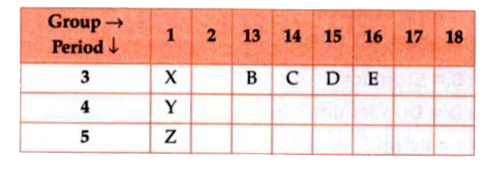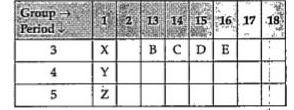If period number and grou number of any representative element(s) are same then which of the following statement is incorrect regarding such type element(s) in their ground state? (period number and group number are according to modern form of periodic table)
The possible value of principan quantum number is 2
The possible value of azimuthal quantum number is zero
The possible value of magnetic quantum number is 1
the species could be paramagnetic
The correct Answer is:C
To solve the question, we need to analyze the statements regarding representative elements whose period number and group number are the same. The only representative elements that fit this criterion are hydrogen and beryllium.
1. Identify the Elements:
- The elements with the same period number and group number are hydrogen (H) and beryllium (Be).
- Hydrogen is in period 1, group 1, and beryllium is in period 2, group 2.
2. Examine the Ground State Electronic Configurations:
- Hydrogen has the electronic configuration of 1s¹.
- Beryllium has the electronic configuration of 1s² 2s².
3. Evaluate Each Statement:
- Statement 1: "The possible value of principal quantum number is 2."
- For beryllium (2s²), the principal quantum number (n) is indeed 2. However, for hydrogen (1s¹), the principal quantum number is 1. Thus, this statement is correct for beryllium but not for hydrogen.
- Statement 2: "The possible value of azimuthal quantum number is 0."
- The azimuthal quantum number (l) for the s subshell is 0. Both hydrogen and beryllium have their outermost electrons in the s subshell, making this statement correct.
- Statement 3: "The possible value of magnetic quantum number is 1."
- The magnetic quantum number (m) can take values from -l to +l. Since l = 0 for s subshells, the only possible value for m is 0. Therefore, this statement is incorrect.
- Statement 4: "The species could be paramagnetic."
- Hydrogen has one unpaired electron, making it paramagnetic. Beryllium, with paired electrons, is diamagnetic. Thus, this statement is correct for hydrogen.
4. Conclusion:
- The incorrect statement regarding the representative elements (hydrogen and beryllium) is Statement 3: "The possible value of magnetic quantum number is 1."
Final Answer:
The incorrect statement is: The possible value of magnetic quantum number is 1.
---
- The elements with the same period number and group number are hydrogen (H) and beryllium (Be).
- Hydrogen is in period 1, group 1, and beryllium is in period 2, group 2.
- Hydrogen has the electronic configuration of 1s¹.
- Beryllium has the electronic configuration of 1s² 2s².
- Statement 1: "The possible value of principal quantum number is 2."
- For beryllium (2s²), the principal quantum number (n) is indeed 2. However, for hydrogen (1s¹), the principal quantum number is 1. Thus, this statement is correct for beryllium but not for hydrogen.
- Statement 2: "The possible value of azimuthal quantum number is 0."
- The azimuthal quantum number (l) for the s subshell is 0. Both hydrogen and beryllium have their outermost electrons in the s subshell, making this statement correct.
- Statement 3: "The possible value of magnetic quantum number is 1."
- The magnetic quantum number (m) can take values from -l to +l. Since l = 0 for s subshells, the only possible value for m is 0. Therefore, this statement is incorrect.
- Statement 4: "The species could be paramagnetic."
- Hydrogen has one unpaired electron, making it paramagnetic. Beryllium, with paired electrons, is diamagnetic. Thus, this statement is correct for hydrogen.
- The incorrect statement regarding the representative elements (hydrogen and beryllium) is Statement 3: "The possible value of magnetic quantum number is 1."
The incorrect statement is: The possible value of magnetic quantum number is 1.
Topper's Solved these Questions
- PERIODIC PROPERTIESBook:VK JAISWALChapter:PERIODIC PROPERTIESExercise:MATCH THE COLUMN
Explore 13 Videos
- PERIODIC PROPERTIESBook:VK JAISWALChapter:PERIODIC PROPERTIESExercise:ASSERTION-REASON TYPE QUESTIONS
Explore 35 Videos
- PERIODIC PROPERTIESBook:VK JAISWALChapter:PERIODIC PROPERTIESExercise:Level 1
Explore 198 Videos
- p-BLOCK ELEMENTSBook:VK JAISWALChapter:p-BLOCK ELEMENTSExercise:SUBJECTIVE PROBLEMS
Explore 36 Videos
- QUALITATIVE INORGANIC ANALYSISBook:VK JAISWALChapter:QUALITATIVE INORGANIC ANALYSISExercise:SUBJECTIVE PROBLEMS
Explore 5 Videos
Similar Questions
Knowledge Check
The total number of groups in the modern periodic table is
A6B7C8D18What is the number of groups and periods in the modern periodic table?
A18, 7B18, 8C16, 7D16, 8The period number and group number of element having atomic number 50 are respectively :
A6th,12thB5th,15thC6th,14thD5th,14th
Position of element, having atomic number 25, in the modern periodic table.
View Solution
The number of period that the modern periodic table has :
View SolutionThe number of elements in the 4th period of periodic table is
View SolutionThe number of elements in the 4th period of periodic table is
View SolutionTotal number of elements present in 5 th period of modern periodic table is
View Solution

